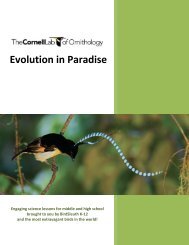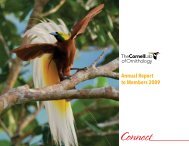Appendix D.Sample Design <strong>and</strong> Statistical AccuracyThis appendix is presented in two parts.The first part is the U.S. Census BureauSource <strong>and</strong> Accuracy Statement. Thisstatement describes the samplingdesign for the 2011 <strong>Survey</strong> <strong>and</strong>highlights the steps taken to produceestimates from the completed questionnaires.The statement explains theuse <strong>of</strong> st<strong>and</strong>ard errors <strong>and</strong> confidenceintervals. It also provides comprehensiveinformation about errors characteristic<strong>of</strong> surveys <strong>and</strong> formulas <strong>and</strong>parameters to calculate an approximatest<strong>and</strong>ard error or confidence interval foreach number published in this report.The second part, Tables D-1 to D-5,reports approximate st<strong>and</strong>ard errors<strong>and</strong> 95-percent confidence intervalsfor selected measures <strong>of</strong> participation<strong>and</strong> expenditures for wildlife-relatedrecreation.Source <strong>and</strong> Accuracy Statement forthe 2011 <strong>National</strong> <strong>Survey</strong> <strong>of</strong> <strong>Fishing</strong>,<strong>Hunting</strong>, <strong>and</strong> <strong>Wildlife</strong>-AssociatedRecreationSOURCE OF DATAThe estimates in this report are basedon data collected in the 2011 <strong>National</strong><strong>Survey</strong> <strong>of</strong> <strong>Fishing</strong>, <strong>Hunting</strong>, <strong>and</strong> <strong>Wildlife</strong>-AssociatedRecreation (FHWAR)conducted by the Census Bureau <strong>and</strong>sponsored by the U.S. Fish <strong>and</strong> <strong>Wildlife</strong>Service.The eligible universe for the FHWARis the civilian noninstitutionalized <strong>and</strong>nonbarrack military population livingin the United States. The institutionalizedpopulation, which is excludedfrom the population universe, iscomposed primarily <strong>of</strong> the populationin correctional institutions <strong>and</strong> nursinghomes (98 percent <strong>of</strong> the 4 millioninstitutionalized people in Census2010).The 2011 <strong>Survey</strong> was designed toprovide state-level estimates <strong>of</strong> thenumber <strong>of</strong> participants in recreationalhunting <strong>and</strong> fishing <strong>and</strong> in wildlifewatching activities (e.g., wildlife observation).Information was collected onthe number <strong>of</strong> participants, where <strong>and</strong>how <strong>of</strong>ten they participated, the type <strong>of</strong>wildlife encountered, <strong>and</strong> the amounts<strong>of</strong> money spent on wildlife-relatedrecreation.The survey was conducted in twostages: an initial screening <strong>of</strong> householdsto identify likely sportspersons<strong>and</strong> wildlife-watching participants <strong>and</strong>a series <strong>of</strong> follow-up interviews <strong>of</strong>selected persons to collect detailed dataabout their wildlife-related recreationduring 2011.SAMPLE DESIGNThe 2011 FHWAR sample was selectedfrom the Census Bureau’s masteraddress file (MAF).The FHWAR is a multistage probabilitysample, with coverage in all 50states <strong>and</strong> the District <strong>of</strong> Columbia. Inthe first stage <strong>of</strong> the sampling process,primary sampling units (PSUs) areselected for sample. The PSUs aredefined to correspond to the Office <strong>of</strong>Management <strong>and</strong> Budget definitions<strong>of</strong> Core Based Statistical Area definitions<strong>and</strong> to improve efficiency infield operations. The United States isdivided into 2,025 PSUs. These PSUsare grouped into 824 strata. Withineach stratum, a single PSU is chosenfor the sample, with its probability <strong>of</strong>selection proportional to its populationas <strong>of</strong> the 2000 decennial census. ThisPSU represents the entire stratum fromwhich it was selected. In the case <strong>of</strong>strata consisting <strong>of</strong> only one PSU, thePSU is chosen with certainty.Within the selected PSUs, the FHWARsample was selected from the MAF.FHWAR Screening SampleThe total screening sample in theUnited States consisted <strong>of</strong> 48,600households. Interviewing for the screenwas conducted during April, May,<strong>and</strong> June 2011. Due to a high noncontactrate, an additional personal visitscreening interview, for a subsample<strong>of</strong> noncontact cases, occurred again inFebruary, March, April, or May 2012.Of all housing units in sample, about42,800 were determined to be eligiblefor interview. Interviewers obtainedinterviews at 30,400 <strong>of</strong> these units fora national response rate <strong>of</strong> 71 percent. 1The national weighted response ratewas 77 percent. The interviewers askedscreening questions for all householdmembers 6 years old <strong>and</strong> older. Noninterviewsoccur when the occupantsare not found at home after repeatedcalls or are unavailable for some otherreason.Data for the FHWAR sportspersonssample <strong>and</strong> wildlife-watchers samplewere collected in three waves. 2 Thefirst wave started in April 2011, thesecond in September 2011, <strong>and</strong> thethird in January 2012. In the sportspersonssample, all persons who huntedor fished in 2011 by the time <strong>of</strong> thescreening interview were interviewed inthe first wave. The remaining sportspersonsin sample were interviewed in thesecond wave. The reference period wasthe preceding 4 months for waves 1 <strong>and</strong>2. In wave 3, the reference period waseither 4, 8, or 12 months dependingon when the sample person was firstinterviewed.1Response rates are calculated by using APPOR’s RR2formula.2The sample cases selected due to high noncontact rateswere only interviewed once. They received a screener<strong>and</strong>, if they had some form <strong>of</strong> participation, a detailedquestionnaire. These participants did not get three waves<strong>of</strong> interviewing. The reference period for these sampledcases was between 13 <strong>and</strong> 16 months.120 2011 <strong>National</strong> <strong>Survey</strong> <strong>of</strong> <strong>Fishing</strong>, <strong>Hunting</strong>, <strong>and</strong> <strong>Wildlife</strong>-Associated Recreation U.S. Fish <strong>and</strong> <strong>Wildlife</strong> Service <strong>and</strong> U.S. Census Bureau
Detailed SamplesTwo independent detailed samples werechosen from the FHWAR screeningsample. One consisted <strong>of</strong> sportspersons(people who hunt or fish) <strong>and</strong> theother <strong>of</strong> wildlife watchers (people whoobserve, photograph, or feed wildlife).A. SportspersonsThe Census Bureau selected thedetailed samples based on informationreported during the screeningphase. Based on informationcollected from the householdrespondent, every person 16 yearsold <strong>and</strong> older in the FHWARscreening sample was assigned to asportspersons stratum. The criteriafor the strata included time devotedto hunting or fishing in previousyears, participation in hunting orfishing in 2011 by the time <strong>of</strong> thescreening interview, <strong>and</strong> intentionsto participate in hunting <strong>and</strong> fishingactivities during the remainder<strong>of</strong> 2011. 3 The four sportspersonscategories were:1. Active—a person who hadalready participated in huntingor fishing in 2011 at the time <strong>of</strong>the screener interview.2. Likely—a person who had notparticipated in 2011 at the time<strong>of</strong> the screener, but had participatedin 2010 OR was likely toparticipate in 2011.3. Inactive—a person who had notparticipated in 2010 or 2011AND was somewhat unlikely toparticipate in 2011.4. Nonparticipant—a person whohad not participated in 2010 or2011 AND was very unlikely toparticipate in 2011.Due to the high noncontact rates inwave 1, all persons in the active,likely, <strong>and</strong> inactive groups wereselected with certainty.Active sportspersons were giventhe detailed interview twice—atthe time <strong>of</strong> the screening interview(in April, May, or June 2011) <strong>and</strong>3The sample cases selected due to high noncontact rateswere not assigned a sportsperson stratum.again in January or February 2012. 4Likely sportspersons <strong>and</strong> inactivesportspersons were also interviewedtwice—first in Septemberor October 2011, then in Januaryor February 2012. Persons in thenonparticipant group were noteligible for a detailed interview.<strong>About</strong> 16,400 persons were designatedfor interviews in the UnitedStates. The detailed sportspersonssample sizes varied by state toget reliable state-level estimates.During each interview period,about 31 percent <strong>of</strong> the designatedpersons were not found at home orwere unavailable for some otherreason. Overall, about 11,300detailed sportspersons interviewswere completed at a response rate<strong>of</strong> 69 percent.B. <strong>Wildlife</strong> WatchersThe wildlife-watching detailedsample was also selected based oninformation reported during thescreening phase. Based on informationcollected from the householdrespondent, every person 16 yearsold <strong>and</strong> older was assigned to astratum. The criteria for the strataincluded time devoted to wildlifewatchingactivities in previousyears, participation in wildlifewatchingactivities in 2011 by thetime <strong>of</strong> the screening interview,<strong>and</strong> intentions to participate inwildlife-watching activities duringthe remainder <strong>of</strong> 2011. The fivewildlife-watching categories were:1. Active—a person who hadalready participated in 2011at the time <strong>of</strong> the screeninginterview.2. Avid—a person who had not yetparticipated in 2011, but in 2010had taken trips to participate inwildlife-watching activities for21 or more days or had spent$300 or more.3. Average—a person who had notyet participated in 2011, but in2010 had taken trips to wildlifewatch for less than 21 days <strong>and</strong>had spent less than $300 ORhad not participated in wildlifewatchingactivities but was very4The sample cases selected due to high noncontact rateswere given the detailed sportsperson interview once.likely to in the remainder <strong>of</strong>2011.4. Infrequent—a person who hadnot participated in 2010 or2011, but was somewhat likelyor somewhat unlikely to participatein the remainder <strong>of</strong> 2011.5. Nonparticipant—a person whohad not participated in 2010 or2011 AND was very unlikely toparticipate during the remainder<strong>of</strong> 2011.Persons were selected for thedetailed sample based on thesegroupings, but persons in thenonparticipant group were noteligible for a detailed interview.A subsample <strong>of</strong> each <strong>of</strong> the othergroups was selected to receivea detailed interview with thechance <strong>of</strong> selection diminishingas the likelihood <strong>of</strong> participationdiminished. <strong>Wildlife</strong>-watchingparticipants were given the detailedinterview twice. 5 Some receivedtheir first detailed interview atthe same time as the screeninginterview (in April, May, or June2011). The rest received their firstdetailed interview in Septemberor October 2011. <strong>All</strong> wildlifewatchingparticipants receivedtheir second interview in Januaryor February 2012. Some respondentswere given the screener <strong>and</strong>detailed interview in February,March, April, or May 2012. <strong>About</strong>13,900 persons were designated forinterviews in the United States. Thedetailed wildlife-watching samplesizes varied by state to get reliablestate-level estimates. During eachinterview period, about 33 percent<strong>of</strong> the designated persons were notfound at home or were unavailablefor some other reason. Overall,about 9,300 detailed wildlifewatcher interviews were completedat a response rate <strong>of</strong> 67 percent.ESTIMATION PROCEDURESeveral stages <strong>of</strong> adjustments wereused to derive the final 2011 FHWARperson weights. A brief description <strong>of</strong>the major components <strong>of</strong> the weights isgiven below. <strong>All</strong> statistics for the popu-5The sample cases selected due to high noncontact rateswere given the detailed wildlife-watching interviewonce.U.S. Fish <strong>and</strong> <strong>Wildlife</strong> Service <strong>and</strong> U.S. Census Bureau 2011 <strong>National</strong> <strong>Survey</strong> <strong>of</strong> <strong>Fishing</strong>, <strong>Hunting</strong>, <strong>and</strong> <strong>Wildlife</strong>-Associated Recreation 121
- Page 1:
U.S. Fish & Wildlife Service2011Nat
- Page 4 and 5:
Economics and StatisticsAdministrat
- Page 6 and 7:
List of TablesFishing and Hunting1.
- Page 8 and 9:
ForewordWhen I was growing up, it w
- Page 11 and 12:
Highlights
- Page 13 and 14:
watching (observing, photographing,
- Page 15 and 16:
Expenditures for Wildlife-Related R
- Page 17 and 18:
Fishing
- Page 19 and 20:
Fishing ExpendituresAnglers spent $
- Page 21 and 22:
Freshwater Fishing ExpendituresAngl
- Page 23 and 24:
pike, pickerel, and muskie, as well
- Page 25 and 26:
Sex and Age of AnglersAlthough more
- Page 27 and 28:
The majority of anglers had househo
- Page 29:
2001-2011 Fishing Participants, Day
- Page 32 and 33:
Hunting HighlightsIn 2011, 13.7 mil
- Page 34 and 35:
Big Game HuntingIn 2011, a majority
- Page 36 and 37:
Days per hunterTrips per hunterTrip
- Page 38 and 39:
Hunting on Public and PrivateLandsm
- Page 40 and 41:
Large MSA25%Medium MSA17%Percent of
- Page 42 and 43:
Hispanics, who represent a growingp
- Page 45 and 46:
Wildlife WatchingU.S. Fish and Wild
- Page 47 and 48:
Wildlife-Watching ExpendituresThirt
- Page 49 and 50:
Wildlife Fed, Observed, orPhotograp
- Page 51 and 52:
Metropolitan and NonmetropolitanAro
- Page 53 and 54:
Education, Race, and Ethnicity ofAr
- Page 55 and 56:
Away-From-Home Participantsby Type
- Page 57 and 58:
Away-From-Home WildlifeWatchers by
- Page 59 and 60:
Metropolitan and NonmetropolitanAwa
- Page 61 and 62:
2001-2011 Comparison of Wildlife-Wa
- Page 63:
2006-2011 Wildlife-Watching Partici
- Page 66 and 67:
Guide to Statistical TablesPurpose
- Page 68 and 69:
Table 3. Freshwater Anglers and Day
- Page 70 and 71:
Table 7. Hunters and Days of Huntin
- Page 72 and 73:
Table 8. Selected Characteristics o
- Page 74 and 75:
Table 9. Selected Characteristics o
- Page 76 and 77:
Table 10. Selected Characteristics
- Page 78 and 79:
Table 12. Expenditures for Fishing:
- Page 80 and 81: Table 14. Trip and Equipment Expend
- Page 82 and 83: Table 16. Trip and Equipment Expend
- Page 84 and 85: Table 18. Trip and Equipment Expend
- Page 86 and 87: Table 20. Trip and Equipment Expend
- Page 88 and 89: Table 22. Special Equipment Expendi
- Page 90 and 91: Table 25. Freshwater Anglers and Da
- Page 92 and 93: Table 29. Hunters and Days of Hunti
- Page 94 and 95: Table 33. Hunters Preparing for Hun
- Page 96 and 97: Table 37. Participation in Wildlife
- Page 98 and 99: Table 40. Expenditures for Wildlife
- Page 100 and 101: Table 41. Selected Characteristics
- Page 102 and 103: Table 42. Selected Characteristics
- Page 104 and 105: Table 46. Total Wildlife-Related Pa
- Page 106 and 107: Appendix A.DefinitionsAnnual househ
- Page 108 and 109: State governments (such as State pa
- Page 110 and 111: Appendix B.2010 Participation of 6-
- Page 112 and 113: Table B-4. Most Recent Year of Fish
- Page 114 and 115: Table B-7. Selected Characteristics
- Page 116 and 117: Table B-9. Participation by 6-to-15
- Page 118 and 119: Appendix C.Significant Methodologic
- Page 120 and 121: Table C-1. Major Characteristics of
- Page 122 and 123: Table C-2. Anglers and Hunters by C
- Page 124 and 125: household income in the 2001Survey.
- Page 126 and 127: Table C-4. Comparison of Major Find
- Page 128 and 129: Table C-5. Anglers and Hunters by C
- Page 132 and 133: lation 6 to 15 years of age were de
- Page 134 and 135: compute in advance the standard err
- Page 136 and 137: Illustration of the Computation of
- Page 138 and 139: Table D-2. Approximate Standard Err
- Page 140 and 141: Table D-4. Approximate Standard Err
- Page 143: U.S. Department of the InteriorU.S.






